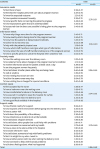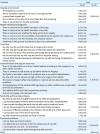2. Korean Society of Obstetrics and Gynecology. Obstetrics. 5th ed. Seoul: Korean Society of Obstetrics and Gynecology;2015. p. 561–585.
3. Maloni JA. Antepartum bed rest for pregnancy complications: efficacy and safety for preventing preterm birth. Biological Research for Nursing. 2010; 12(2):106–124.

4. Kim MK, Lee YH, Cho IS, Lim JY. Change of stress and nursing needs after hospitalization in preterm labor women. Korean Journal of Women Health Nursing. 2009; 15(1):24–31.

5. Cole-Lewis HJ, Kershaw TS, Earnshaw VA, Yonkers KA, Lin H, Ickovics JR. Pregnancy-specific stress, preterm birth, and gestational age among high-risk young women. Health Psychology. 2014; 33(9):1033–1045.

6. May KA. Impact of maternal activity restriction for preterm labor on the expectant father. Journal of Obstetric, Gynecologic, and Neonatal Nursing. 1994; 23(3):246–251.
7. Chen MJ, Grobman WA, Gollan JK, Borders AE. The use of psychosocial stress scales in preterm birth research. American Journal of Obstetrics and Gynecology. 2011; 205(5):402–434.

8. Go JI, Kim KH, Yeoum SG. Relationship with physical suffering, emotional state, and nursing needs of pregnant women in preterm labor. Korean Journal of Women Health Nursing. 2009; 15(4):280–293.

9. Kim JI, Cho MO, Choi GY. Multiple factors in the second trimester of pregnancy on preterm labor symptoms and preterm birth. Journal of Korean Academy of Nursing. 2017; 47(3):357–366.

10. Di Renzo GC, Giardina I, Rosati A, Clerici G, Torricelli M, Petraglia F. Maternal risk factors for preterm birth: a country-based population analysis. European Journal of Obstetrics, Gynecology, and Reproductive Biology. 2011; 159(2):342–346.

11. Kang MC, Cho HJ, Choi SJ, Han SJ, Song CH. Epidemiologic study of preterm birth in Chosun University Hospital. Korean Journal of Obstetrics and Gynecology. 2004; 47(5):931–937.
12. Seravalli L, Patterson F, Nelson DB. Role of perceived stress in the occurrence of preterm labor and preterm birth among urban women. Journal of Midwifery & Women's Health. 2014; 59(4):374–379.

13. Lee JY, Choi ES. Stress and coping style of high-risk pregnant women's spouses. Korean Journal of Women Health Nursing. 2010; 16(3):234–244.

14. Maloni JA, Ponder MB. Fathers' experience of their partners' antepartum bed rest. Image: The Journal of Nursing Scholarship. 1997; 29(2):183–188.

15. Hsieh YH, Kao CH, Gau ML. The lived experience of first-time expectant fathers whose spouses are tocolyzed in hospital. Journal of Nursing Research. 2006; 14(1):65–74.

16. Kim KW, Lee KH. Woman's experience of risk situation on the high-risk pregnancy. Journal of Korean Academy of Women's Health Nursing. 1998; 4(1):121–133.
17. Nie C, Dai Q, Zhao R, Dong Y, Chen Y, Ren H. The impact of resilience on psychological outcomes in women with threatened premature labor and spouses: a cross-sectional study in Southwest China. Health and Quality of Life Outcomes. 2017; 15(1):26.

18. Choi SH, Kim HJ, Kim KY, Lee SW. The effects of stress and its related factors on pregnant women in preterm labor. Journal of the Korean Society of Maternal and Child Health. 2011; 15(2):230–240.
19. Yu WJ, Song JE. Effects of abdominal breathing on state anxiety, stress, and tocolytic dosage for pregnant women in preterm labor. Journal of Korean Academy of Nursing. 2010; 40(3):442–452.

20. Son HJ, Park JS. Relationship between preterm labor stress, fetal attachment and maternal role confidence in pregnant women with preterm labor. Journal of The Korean Society of Maternal and Child Health. 2014; 18(1):86–96.
21. Kim NH, Tae YS, Choi YS, Bae JH. Influencing factors on stress in caregivers of stroke patients being admitted in rehabilitation centers. Journal of the Korea Academia-Industrial Cooperation Society. 2016; 17(2):188–201.

22. Jang S. Needs of the family members of intensive care unit patients [master's thesis]. Seoul: Hanyang University;2007. p. 69.
23. Wilson-Barnett J, Carrigy A. Factors influencing patients' emotional reactions to hospitalization. Journal of Advanced Nursing. 1978; 3(3):221–229.

24. Kim SH, Cho Chung HI. Stress, coping style and nursing needs for hospitalized pregnant women due to preterm labor. Korean Journal of Women Health Nursing. 2015; 21(2):83–92.

25. Noftall A. The experience of men whose partners are hospitalized for high-risk pregnancies - a phenomenological study [master's thesis]. Newfoundland: Memorial University of Newfoundland;2000. 150.
26. Su YT, Chen FH. Paternal grief and nursing care in perinatal deaths. Hu Li Za Zhi The Journal of Nursing. 2013; 60(6):90–95.
27. Armstrong DS, Hutti MH, Myers J. The influence of prior perinatal loss on parents' psychological distress after the birth of a subsequent healthy infant. Journal of Obstetric, Gynecologic, and Neonatal Nursing. 2009; 38(6):654–666.

28. Wang HJ, Park HS, Kim IO. Comparison of prenatal health management state and educational needs for pregnant women with advanced maternal age and under the age of 35. Korean Journal of Women Health Nursing. 2013; 19(4):230–241.

29. Kent RA, Yazbek M, Heyns T, Coetzee I. The support needs of high-risk antenatal patients in prolonged hospitalisation. Midwifery. 2015; 31(1):164–169.

30. Condon JT, Boyce P, Corkindale CJ. The first-time fathers study: a prospective study of the mental health and wellbeing of men during the transition to parenthood. Australian and New Zealand Journal of Psychiatry. 2004; 38(1-2):56–64.








 PDF
PDF ePub
ePub Citation
Citation Print
Print





 XML Download
XML Download